-
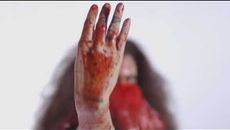
'MS'
A video work made with young West Sydney based 'nesian designers. (Samoa, Tonga, Maori, Fijian)make up artists, models, filmmakers, as part of the community engagement for the Towards the Mourning Sun exhibition in Campbelltown, Sydney, Australia. Founded in 2010 by Rosanna Raymond The SaVAge K’lub presents 21st Century South Sea SaVAgery, influencing art and culture through the interfacing of time and space, deploying weavers of words, rare anecdotalists, myth makers, hip shakers, navigators, red faces, fabricators, activators, installators to institute the non cannibalistic cognitive consumption of the other. Da SaVAge K’lub is proud to present the inaugural Australian SaVAge K’lub initiating a space within the exhibition for local artists and designers to present their work inside the gallery space alongside established artists, asking them to respond to the themes embedded in Towards the Mourning Sun. Raymond’s practice works with people, spaces and things to activate a dynamic relationship between them, to realise and reshape the ta-va duality. This is a choreographic process that extends beyond the frames of art, into both domestic routines and ritual protocols. It includes self-adornment and group enactments, activating space and collapsing time using the body and the genealogical matter, producing art, which communicates social commentary, histories and expresses the new visual landscape of the urban indigeneity.
-
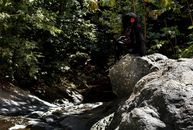
'Telesā' the song
Lindah Lepou is a multidisciplinary artist whose work has been displayed around the world. Her recent work of art on display for the public to be moved by was her song “Telesā” that was the theme music of the series “Teine Sā”. Lindah has long made her mark as a Pacific artist across many genres - as a soul singer, award winning designer and multimedia artist. Her many ventures in life have taken her from the runways of Australia and the Pacific to the stages of Europe, but at her heart will always be her Samoan gafa and lineage, which has shown itself in her many stories on stage, sound and screen. {{23861}} The song Telesā captured audiences to the extent that people started tweeting how they were just listening repeatedly to the opening titles of the Teine Sā series so they could play Lindah’s song. Luckily for listeners everywhere “Telesā” is now available on all streaming platforms including Spotify and can be downloaded or streamed in to your playlists! {{23892}} We had the chance to speak to Lindah about her art and the inspiration behind ‘Telesā’, heres what she had to say: What was the inspiration behind the song Telesā? The ‘Telesā’ song was created in 2012 (almost a decade ago) to launch my three-part multidisciplinary, “AITU Series” that celebrates and communicates with three specific AITU I am directly linked to through my own ancient Samoan gafa (lineage), using modern palagi tools. I recorded this song in London, UK with the love and support of Robert O’Brien, who helped me record what I was hearing in my vision by engaging our Samoan soprano, Aivale Cole to compose within a traditional ‘Palagi’ classical discipline while using her haunting Samoan vocal from deeper layers of emotion while still maintaining an untainted rawness and fluidity in its simplicity. {{23890}} Many people on Twitter are saying they have your music on repeat after hearing it in Teine Sā. How important do you feel music is in telling our Pacific stories? Anyone who knows me knows that everything I’ve created as a multidimensional artist is anchored in my own unique pacific (and palagi) gafa. It is important to tell our own PACIFIC stories with our ancient pacific narrative (pre-colonization) as it was carried through our oral traditions and art practices, instead of having post-colonial donkeys who have no idea who they are reimagining our pacific identity in the wrong way. {{23863}} The stories of the Teine Sā series are deep and intense, to which the music fits perfectly. When putting together this song what feeling were you hoping to invoke from the audience? My main intention is to stay true to my own relationship and fa’aaloalo (respect) for my own AITU loved ones who’ve continued to support and protect me from the vā (invisible). If anyone is inspired to reconnect and/or embrace their own unique identity by looking into their own gafa (whakapapa/heritage) for healing, upliftment, and comfort, then I’m here for it because that’s what it does for me. {{23888}}
-
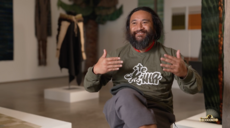
14 Malone Road | Creative NZ Arts Profile
Welcome back to Measina Festival 2023! Join us as we sit down with award-winning choreographer and dancer Tupua Tigafua, along with the cast of his latest work '14 Malone Road,' which takes us on a personal journey of nostalgia for a family home through song, dance, and theatre.
-
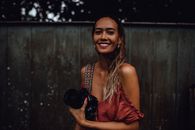
Alex King Photography
Alex King is a Cook Island photagrapher based in Rarotonga. She tells us how she got into photography, the images she loves to capture and the stories she wants to tell. Fully a #CreativeNative
-
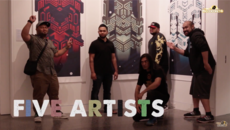
Altered Egos Exhibition
The five men whose works feature in the Altered Egos exhibition each have a gift of a superpower. They can each redefine the sense of self through illustration. Just by the simple move of a pen, they can turn sneakers into something fabulous. Altered Egos highlights the artist's ability to change or alter our perceptions of self, simply by using line and shade and texture. The interactive exhibition of illustration and animation features two world-class illustrators from Mangere - Michel Mulipola and Ali Cowley alongside a group of emerging illustration or animation talents from around Tamaki Makaurau. This is their first exhibition as a collective and alongside their work the public can see much more. They have used techology to demonstrate some behind the scenes working methods, such as 3D printing, animation and holograms. Altered Egos celebrates the work of pop-culture creative industries that don't often find their way into a gallery. It underscores the impact of the trend in graphic novems in current literature. More importantly however, it gives visibility to masculine creative identity on a large and inspiring scale. Altered Egos features the works of some of the Pacific's best - Ali Cowley, Michel Mulipola, Nanai Tolovae Jr, Jimmy Vea and Te Iwihoko Te Rangihirawea and is on at Mangere Arts Centre from now - 14 Jan 2017! Suggested Links: From the Pacific to Pingyao Janet Lilo - Status Update
-

ANE TONGA - ARTIST PROFILE
ANE TONGA Artist/ Curator of Pacific Art & Inaugral curator of Pacific Art in Toi o Tamaki, Auckland Art Gallery Tongan . My name is Ane Tonga and I am from the villages of Vaini and Kolofo’ou. I was born and raised in Auckland-in Mount Wellington/East Side to be exact. {{17189}} You and your older sister Nina are both Arts Curators in a major NZ gallery and museum - are you unicorns? How unique and important is this for Moana people? Unicorns are closely related to horses and we’re Tongan so watch out, ha! All joking aside, Nina and I aren’t dissimilar to other Tongan and Pacific people; we are proud of our heritage and demand nothing less than excellence when it comes to the work that we do to serve indigenous and Pacific peoples. In saying that, curatorial roles in Aotearoa are certainly coveted so that fact that my sister and I hold these positions is rare as much as it is political. You could say that we’re kind of the antithesis of what would come to mind when you think of a museum/gallery curator- brown, female, young (in curator years which is like dog years). But I’m very aware of the responsibility that comes with being the inaugural Curator of Pacific Art in Toi o Tāmaki, (Auckland Art Gallery) as is Nina who is the first Pacific person to ever hold the role of Curator of Contemporary Art at Te Papa (our national museum). It’s also important not to see us in isolation but rather that we’re here because of other pioneering Pacific academics and curators who have helped pave a way and continue to mentor us like Sean Mallon and Dr Caroline Vercoe amongst many others. There are other non-Pacific professionals that have also mentored us like Sarah Farrar, Jenny Harper and Tim Walker. Most importantly, we also draw strength from our family who are with us through all of these milestones and keep us grounded. {{17191}} Tell us how you got into arts and what has your work been focused on? Art has been part of my life since I was born. My grandmother keeps and maintains ngātu and every summer she would bring it out and repaint parts of the patterning using a concoction of different materials. I studied photography and art history subjects in high school, then went on to study at Elam School of Fine Arts and specialised in photography. I was lucky to find employment in the arts upon graduating. I did my first curatorial internship at the Dowse Art Museum in Lower Hutt and from there curating as a profession has provided me with opportunities to work and live in different parts of the Aotearoa. My research has been focused on contemporary Pacific art and curatorial practice, lens-based practices and indigenous feminisms. My writing for art publications and catalogues has focused primarily on female artists of Māori and Pacific descent. {{17193}} I maintain an art practice but luckily I’m a bit of a slow burner so I don’t feel like there’s a tension between my role as an artist and curator. . {{17195}} How big a deal is it that a Pasifika person is curating at the Akl Gallery? We all know that it's a long time coming in the biggest Polynesian city in the world but how much of an impact are you hoping to make there? It’s a momentous occasion, for me, my family and for the Pacific. I’m grateful for the Auckland Art Gallery Foundation who have made this role possible as well as others who have contributed towards it. As you say, it’s been a long time coming and has taken many people to get us here.Although it’s early days (I’m in week two of the job!) I’m really focused on seeing our gallery increase access and engagement with Pacific art and artists. I’m keen to develop the Pacific collection and produce targeted research that will have wider output than exhibitions and publications. Through that work we can give greater visibility to the a spectrum of Pacific narratives and experiences. Ultimately, what I’m wanting in terms of impact is to ensure that this role will continue long after my time and, in doing so, create the curatorial infrastructure that will see that our Pacific artists and communities thrive into the future. {{17198}} What's exciting about Pasifika arts in Aotearoa at the moment - what gives you hope and inspiration for what Pasifika artists are saying today? I don’t know that there’s ever been a moment (past or present) where I haven’t been excited about Pacific arts. Pacific artists today are part of a wave of changes that has waxed and waned, and can be as ephemeral as hope and inspiration that is tested, pushed and restored at different times. Not at all surprised that an ocean metaphor slipped into my answer just then. If I could narrow it down to one thing, it is the collective nature of which our Pacific artists and indigenous artists are working within that inspires me. Working towards a shared purpose, the ‘greater good’ if you will, is part of a shift happening that enables the type of changes I want to see in the world.
-
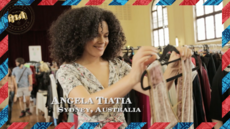
Angela Tiatia from Sydney
As a multimedia artist, Angela Tiatia explores contemporary culture, drawing attention to its relationship to representation, gender, neo-colonialism and the commodification of the body and place. Her work has been exhibited in Köln, Singapore, Los Angeles, San Francisco, New York, Mexico City, Honolulu, Sydney, Melbourne, Auckland and Wellington. Check out more from Angela Tiatia
-
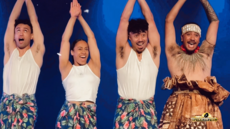
A Niu Dawn - The Guerrilla Collection 2024 Festival Highlights
Catch glimpses from 'A Niu Dawn', the return of The Guerrilla Collection festival on November 23, 2024, at Corban Estate Arts Centre. Celebrating the diverse voices of Moana Oceania artists, this free, one-day event featured original performances, live music, food trucks, and a dedicated kids’ program. With leadership from Neil Ieremia and a range of talented artists like Anapela Polata’ivao, Vela Manusaute, Daren Kamali, and more, the festival brought a Niu perspective on the Dawn Raids and envisions a brighter future for all.
-
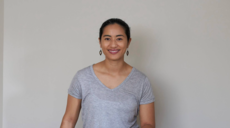
ARTIST PROFILE - ELISABETH KUMARAN
Emerging artist Elisabeth Kumaran is a New Zealand-born, Samoan/Chinese visual artist based in South Auckland. She hails from the villages of Vailele, Ulutogia, and Vailoa-Palauli. The Samoan language, Samoan traditions, and the artists heritage, are core components expressed through her work. Kumaran’s practice spans mediums such as drawing, illustration, hand-drawn stop motion video animation and hand cut paper illustrations. {{32622}} Explanation on work exhibiting at The Ōyster, Ōtara Kumarans’ exhibition at The Ōyster in April was titled ‘Watch me #WIP’ (Work In Progress). #WIP is a hashtag used by many creatives across social to keep viewers abreast of their creative progress, it helps to build a sense of excitement around their work and offers a behind the scenes glimpse into the artists’ journey. Kumarans’ earliest memories are of growing up in Ōtara and discovering a love for drawing. Watch me #WIP was an installation of her studio, a small, private space, filled with music, pot plants, inspirational objects and drawings. {{32620}} Q&A with Elisabeth Kumaran Who is one of your biggest influences? My late parents are my number one influences. They always supported and encouraged me to pursue my creativity. A lot of my work incorporates the Samoan culture and my upbringing and I owe this to how we were brought up at home. {{32624}} What do you love most about being an artist? Being able to express ideas visually, and continuing to explore various mediums and processes. I love that my art can teach others about the fa’asamoa (Samoan culture). {{32627}} What recent exhibition most excited you and why? Moana Artists at Scott Lawrie Gallery, 2022. It was an honour to show alongside some talented Pacific artists. It was exciting to invite family and friends along and they were inspired and amazed at the variety and calibre of Pacific artists in the show. {{32630}} How do you think your heritage informs your art practice? My Samoan heritage and upbringing are the foundations of my art practice. I like to incorporate the Samoan language and culture in my art and stop-motion animations. It helps me to cherish and nurture my fa’asamoa. {{32632}} What is the main message you want to convey through your work in general? A majority of my art practice explores themes around the fa’asamoa using different materials such as: stop motion video animations, hand paper-cut illustrations and installation work. {{32635}}
-
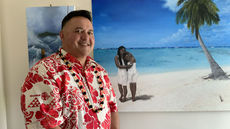
ARTIST PROFILE - THE OYSTER presents CLINTON HEWETT
Based in Manurewa, Clinton Hewett is a Cook Islands Artist and Woodcarver. He works in oil, watercolor and acrylic, and also uses oil pastels and block printing to create depth within his compositions. Clinton Hewett has been working as a woodcarver, artist and storyteller (heritage knowledge bearer) professionally since 1991. His career spans 32 years thus far, beginning in Aitutaki, Cook Islands. Hewetts’ work explores narratives drawn from the cultural heritage of his birthplace and ancestral lands of Aitutaki and Rarotonga, and the experiences of its transformation in the Cook Island diaspora of Aotearoa, New Zealand. {{33112}} Who is one of your biggest influences? Darcy Nicholas and Andy Leleisi’uao and Benjamin Work. {{33114}} What do you love most about being an artist? Darcy Nicholas said “Creating art is my freedom” and it has formed the biggest part of my world for as long as I can remember as a child. {{33120}} What recent exhibition most excited you and why? Marcus Hipa, it was so relatable for me to work from experiences from your homeland and the transcending that takes place when you emigrate away from your world to a new place. {{33116}} How do you think your heritage informs your art practice? It will always be central to my practice but the key for me was to learn and respect our histories while not only looking at our past as it can absorb us and envelop our visual conversations as we develop. {{33118}} What is the main message you want to convey through your work in general? Share my knowledge and interpretations of the two worlds I live in. One, of the heritage lessons I learned in Aitutaki and two, that of the experiences of the existence of our culture in the diaspora of Aotearoa.
-
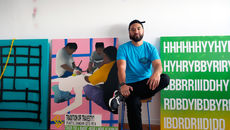
ARTIST PROFILE - THE OYSTER presents GARY SILIPA
Gary is a NZ-born Samoan artist with a varied art practice that includes art education, production, curation, and facilitation. Since 2010 Gary has focused on developing his artwork outside of the letter-based forms of graffiti, which he had been heavily involved in early in his career (1998). This transition sees Silipa producing work that shifts between the streets and indoor settings. Gary’s artwork continues to explore his unique, yet shared identity as a first-generation New Zealander from the Pacific Islands growing up in a modern, urban environment. Outside of making his own art Gary helps to deliver Auckland’s longest running outdoor mural project on behalf of TGTB Charitable Trust, Bradley Lane Project, and leads an artist-run community arts gallery called The Good The Bad Gallery in Glen Innes. {{31786}} The Oyster spoke to Gary about his time exhibiting in Otara below ... This is my second time exhibiting in the Otara location and my exhibition focused on my pride in being Samoan. My parents moved to NZ from Samoa in the early 80’s and I was born in Auckland not long after. My cultural dentity is something I struggled with for a long time. In NZ I was considered a Samoan even though my knowledge of Samoan language and culture is not that strong, but in Samoa I was called a ‘palagi’ since I was from NZ – a reference Samoans use for Europeans. I’ve been pretty settled for a while now thinking I fit somewhere in between yet separate from both. The recent success of the Samoan rugby league team and the parades and pride it showcased (especially in Ōtara) stirred something in me that reminded me that being Samoan is a big part of who I am and I should acknowledge and be proud of that. The exhibition in a way is a thank you to Ōtara for the reminder. {{31788}} - Who is one of your biggest influences? Keith Haring is one of my favourite artists. I like his use of symbols and how simple some of his artwork is drawn yet convey a much deeper meaning if you scratch the surface. You can enjoy it on lots of different levels. {{31790}} What do you love most about being an artist? Making art – the process and final outcome. Usually starts with a rough idea which develops as you work on it with surprising and unexpected results. There’s normally challenges and obstacles faced to move forward or steer you in different directions which keeps it interesting. I really enjoy when the final outcome includes aspects that weren’t anticipated at the beginning or if it was technically challenging and I managed to pull it off. {{31792}} What recent exhibition most excited you and why? I was really looking forward to checking out an exhibition in Melbourne in 2020 with Keith Haring and Jean-Michel Basquiat at the National Gallery of Victoria. Two of my favourite artists. Everything was booked then we went into lockdown a week before leaving. {{31794}} How do you think your heritage informs your art practice? Samoan culture has a strong connection to patterns and symbols that help to identify it. These traditional patterns were created at a particular time and place with references to the surrounding environment on the island. I use this same idea to help me understand what my cultural identity is. But since I was born in an urban environment I create patterns and symbols from my surroundings and what I grew up with experiencing in NZ. {{31796}} What is the main message you want to convey through your work in general? Life. Identity, beliefs and interests from my personal perspective. The good and the bad. Universal stuff I think lots of people can relate to. {{31798}}
-
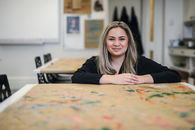
ARTIST PROFILE - THE OYSTER presents JASMINE TE HIRA
Jasmine Te Hira (Cook Islands/Maori & English heritage) is an artist, arts educator and community partnership coordinator based in Tāmaki, Aotearoa. Her current Masters project is based at Unitec Te Whare Wānanga o Wairaka, where she graduated as Senior Scholar from her undergraduate degree in Design and Visual Arts (2016). Jasmine has forged a practice that articulates concepts relating to time, memory and perception through the boundaries of object, video and constructed space, and exhibited most recently at Objectspace and Auckland Art Gallery Toi o Tāmaki. {{32216}} Explanation on work exhibiting at The Ōyster, Ōtara My exhibition at The Ōyster investigates how our surroundings can impact the visual language of our lives. The name for this exhibition is ‘The Architecture of Home’ which is a nod to my south Auckland upbringing while connecting simultaneously to the other homes I have, based in my whakapapa. {{32213}} Recently, the artworks I have been creating consider taonga as ‘shadow sites’ – objects that have the capability to be embedded with hidden or private histories. Each of the works included in this exhibition explores the power of personal adornment and the potential of contemporary taonga to support the retelling of histories, the revoicing of language and memory. {{32210}} Q&A with Jasmine Te Hira Who is one of your biggest influences? My whānau. I come from an incredibly creative whānau on both sides. They have shaped me to see the world the way that I do and I am very thankful for the creative legacy they have provided for us, the next generation {{32218}} What do you love most about being an artist? Making art for me is a way of processing and understanding the world around me. I love encountering and being challenged by knowledge, looking at things from different perspectives and making sense of its interconnectedness. For me, problem solving is at the core of creativity – this is one of the best aspects, having a skill that can translate into finding solutions across a range of life experiences. {{32220}} What recent exhibition most excited you and why? Encountering art can come in many different forms, for me, I often find this in music. The set design for Kendrick Lamar’s most recent Tāmaki tour was awesome to experience. A series of large-scale shadow projections played from ceiling to floor, almost dominating Kendrick’s physical presence on stage. I really enjoy seeing how ‘atmosphere’ can be created by visual and sound elements for art and in exhibitions. {{32223}} How do you think your heritage informs your art practice? My practice is based in whakapapa – the continual learning, understanding and articulation of whakapapa connections. The inheritance of our heritage gives us, as creative practitioners, the ability to navigate past, present and futures that aren’t necessarily time dependent. This is the reason I love researching ‘taonga’. Taonga have an incredible ability to unfold time, complex blends of storytelling over generations that are fluid representations of whakapapa. A taonga that was worn by a great-grandmother can be worn in the present by a great-granddaughter, bringing forward the presence of a maternal line, one which is living in the present world of the next generation. All these experiences of those generations are witnessed by that taonga – holding and embodied knowledge for us to navigate our futures together. {{32227}} What is the main message you want to convey through your work in general? The embedding of our experiences, stories in taonga, the process of creating taonga and handing these taonga on within a whānau, a whakapapa. {{32229}}
-
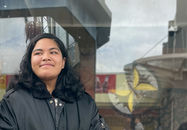
ARTIST PROFILE - THE OYSTER presents SAMARA ALEFAIO
Emerging artist Samara Alefaio (born 2003) started taking her practice seriously in Year 10, and has since furthered her studies to include printmaking (and etching). The artist has transposed her love for greek mythology and it’s statues and scupltures into etched icons, the likes of Percy Jackson and Zeus. Samara also works in acrylic, the fast drying paint allows to express herself quickly and affirmativley. Her painted subjects are usually Samoan weapons and tatau patterns from the Malu. {{31995}} For the installation at The Oyster, the artist recreated an interior setting, to speak to the Pacific Island community of Ōtara. The work includes a contemporary tapa banner, inspired by the artist’s uncle, the late Henry Wilson (1968-2001), whose work wraps The Ōysters outer shell and additional canvases to build out the homely feel. It was Samara’s first solo exhibition outside of school. {{31997}} The Oyster spoke to Samara about her art below ... - Who is one of your biggest influences? My uncle Henry Wilson. {{31999}} What do you love most about being an artist? Being able to express yourself. {{32001}} What recent exhibition most excited you and why? I have grown up surrounded by my Uncle Henrys artworks. It’s in my mums house, all his siblings have his art. {{32003}} How do you think your heritage informs your art practice? Heavily. Mostly my work is based on my own culture. In a way it’s about me learning about it. I come across new patterns. All the patterns have a story. {{32005}} What is the main message you want to convey through your work in general? It’s never too late to learn about your own culture. {{32007}}
-
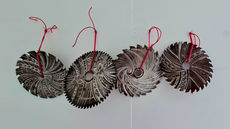
ARTIST PROFILE - THE OYSTER presents TROY JACKSON
Troy Jackson (Niue, Hakupu Atua, Avasele, Ngāpuhi, African American) is a multidisciplinary artist who was born and bred in Ōtara, South Auckland. His art traverses various mediums including glass etching, calligraphy, wood carving, painting and more recently digital art. {{33138}} Early exposure to traditional Māori art forms and study at Ngāti Ōtara and Whai Ora marae has had a significant influence on his practice. Recently, Jackson has completed long-term community studio art residencies with Crosspower Ministries and Massey Homestead working with local youth art programmes. {{33087}} Information about the exhibition at The Ōyster Troy's art installation is a striking reflection on the recent Cyclone that caused havoc across Aotearoa. Circular saw blades, engraved with Pacific motifs, are suspended above miniature vaka, creating an industrial aesthetic that is both powerful and unsettling. However, there is more to this installation than meets the eye. Troy's inspiration for the piece came from a vivid dream he had months before the floods. Incorporating found objects and debris strewn in his yard from the aftermath of the Cyclone, he adds a deeper layer of meaning to the installation. For Troy, the installation is a powerful expression of resilience, creativity, and the transformative power of art. By exploring the intersections between culture, technology, and the natural world, he draws on his own cultural and spiritual traditions to create a work that speaks to the resilience of his community in the face of adversity. Overall, Troys art installation is a testament to the ways in which art can inspire and transform, offering hope and renewal even in the most challenging circumstances. {{33093}} - Who is one of your biggest influences? My parents have a creative background, with my mother being skilled in sewing and weaving and my father drawing cowboys as a child. They both have a fondness for Westerns. My mother, who attended art school for a little while, has a talent for art. I remember her drawing women's faces and fashion illustration. She continues to be creative and expresses herself through crochet, drawing, and painting. She even stitches her designs onto pillows, inspired by the styles of the 1930s. {{33089}} What do you love most about being an artist? I love creating art out of anything and expressing myself in different ways. Art is a huge part of my life, and it's always with me, whether I'm out for a walk or simply relaxing. Whenever I find something dull or uninspiring, I can always find a way to breathe new life into it through my art. My cultural heritage and identity are also reflected in my creations. It's amazing how a single thought can turn into a finished masterpiece, from a rough sketch to a final product. My daughter is my biggest critic, and her feedback always helps me improve. I'm grateful for her support, and I'm proud to share my love of art with my children. Even though they didn't inherit my artistic passion, they support me. {{33091}} What recent exhibition most excited you and why? One of my proudest moments as an artist was when the executives at Telstra asked me to design something for the doors of their building. This was not a recent achievement, but it remains one of my memorable and biggest challenges to date. I designed and engraved by hand all 18 panels for the doors of the Telstra Events Centre (now renamed Due Drop Events Centre) when it opened in Manukau in 2005. This was a massive undertaking that took a couple of weeks to complete. It was an incredible opportunity for me to showcase my skills in glass engraving and to have my work displayed in such a prominent location. I was personally invited by CEO Richard Jefferies (at the time) and I am proud of the final outcome. It was a defining moment in my career and gave me the confidence to pursue more challenging projects. {{33097}} How do you think your heritage informs your art practice? As a person of mixed heritage, it can be challenging to represent designs or motifs from one specific culture, but it's still an integral part of my identity. My work is multicultural and contemporary, and I don't spend too much time planning or designing it. I usually have a clear idea of what I want to create and let the creative process guide me. My designs are a fusion of different cultures, and I don't always explicitly mention the cultural influences unless someone asks. Those who see my art can often see the connections to different cultures, with hints of this and that. Ultimately, my art reflects my diverse background and is a celebration of cultural diversity. {{33095}} What is the main message you want to convey through your work in general? TJ: I create art as a way of expressing myself and showcasing the fusion of different cultures that make up my identity. I want people to see who I am, not just my Niuean heritage. I try to turn negative experiences into positive ones and show that I'm in control of my life. For example, I use the aftermath of a cyclone to capture what it did to everyone, and I create art that draws comparisons between the cyclone and saw blades. I also incorporate natural elements, such as walking sticks, into my work. My faith and Christian background are also reflected in my art. For instance, I create vaka (canoe) designs that represent the Father, Son, and Holy Spirit. When I create, I try to capture the stillness that Jesus speaks of, even amidst chaos and turmoil. Overall, my art is a reflection of who I am, and I hope that it inspires others to embrace their own identities and celebrate cultural diversity. {{33099}} - Jackson is largely self-taught and was trained in calligraphy, signwriting, and glass etching at Whai Ora marae; a Catholic marae in Ōtara, under the tutelage of artist/tutor Sister Monica Swindell. He worked closely with other local artists in training and eventually became the tutor for the bone carving module based at Whai Ora marae. Through his work within the community, and artist residencies Jackson has been able to share his knowledge and skills with the next generation of artists, helping to foster a love for the arts in his community. He continues to create small commissioned pieces for the local community.
-
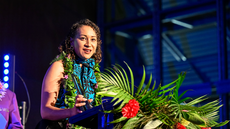
Artists Recognised and Celebrated at CNZ Arts Pasifika Awards 2023
The 2023 Creative New Zealand Arts Pasifika Awards celebrated their champions at Te Papa Museum in Wellington; in an occasion of pride for female Pacific artists who triumphed in most categories, including two remarkable winners in the Senior Pacific Artist category in Cook Islands textile artist Ani O'Neill and Samoa/Māori sculptor Lonnie Hutchinson. These awards stand as a unique national recognition of Pasifika artists from various creative realms, making it a vibrant and globally celebrated annual affair that highlights Pacific artistic brilliance in both Aotearoa and worldwide.
-
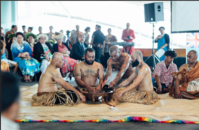
AUCKLAND MUSEUM'S FIJI COLLECTION
Auckland Museum hosted Fijian leaders, performers and community members this past weekend to launch the Museum’s Fijian collection project to coincide with Fijian language week. The Fijian community was welcomed to Auckland Museum on Saturday 1 October to celebrate the launch of a unique project to focus research into the Museum’s internationally recognised Fijian collection. The project is part of The Pacific Collection Access Project, which is a three year programme to open up access to Pacific treasures, creating stronger connections with Auckland’s Pacific communities. As part of the launch, Fijian leaders gifted the project an official Fijian name: ‘Nai Yau Vakaviti – Na Ka Marequiti’ (this means ‘Our Fijian Treasures: That are treasured’). The Fijian collection is the second Pacific island nation to receive focus, following the successful programme of work that has begun for the Cook Islands collection. Museum staff will now focus on engaging with local Fijian communities and will invite cultural knowledge holders to visit the Museum to share their insights and wisdom. From L-R Nacanieli Yalimaiwai, President, Fiji Community Association of Auckland; Fuli Pereira, Auckland Museum Pacific Curator; Minister for Pacific Peoples, Hon Peseta Sam Lotu-Iinga; Reverend Atu Lagi & David Reeves, Auckland Museum Director of Research and Collections We spoke to Tarisi Vunidilo, a Professional Teaching Fellow at the Centre for Pacific Studies, University of Auckland and artist Joana Monolagi who helped come up with the name of the Fijian collection. "I think for me, Joana and Alapati - we had a couple of key words that we'd emailed to each other a few times and then we ended up with the final 5 and then somehow the words started to morph into one. We were thinking about it individually and then one evening it magically came together and the 3 of us just looked at it and we were like "That's it - thats the name!" It's really nice that it has the word "Yau" which is the word for treasures and then it's got "Marequiti" which is to be treasured so those 2 words sort of come together - Our Fijian Treasures .... To be Treasured" said Tarisi "We also had the Rotumans here today and we always say let us not forget our Rotuman brothers and sisters are part of Fiji and they also have Rotuman artifacts that are in the Collection" "For me the name had to speak to what was down in the archives and the importance of it and what it means to us as Fijians. It was really exciting especially to know all the different hands that have created these items and that these items have passed through you know? from generations to generations, what they were used for and how it's here today for this young generation to appreciate their heritage" adds Joana "Yes" agrees Tarisi "to add on to that, Joana touches on a very important point which is our youth, our young people and thats evident today that many of the young people are participating and thats what we want to do with this project. Even though they've been made hundreds of years ago it still has relevance to our young people" L - Tarisi & R - Joana The 2 ladies have also given us a phrase to learn for Fijian Language Week: "Au sa marau" = I am Happy! Vinaka Vakalevu ladies! Photo Credit: Max Lemeshenko/Get Communications for Auckland War Memorial Museum (Top 2 photos) Suggested Links: Pacific Collection Access Project The Pacifica Mamas
-
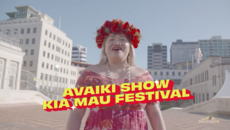
Avaiki Show - Kia Mau Festival
Avaiki! Ardijah jam put their greatest hits on the ukulele and Brother Luv brings ‘Roimata’ to life in this special celebration of Kuki Airani string bands as part of the Kia Mau festival in Wellington.
-
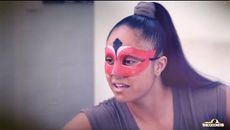
A Woman's Work is a Woman's Worth
Thirteen years ago G Lazaro and NiaVal shared a very special journey - together in a Mangere community centre with 40 women of Pukapukan descent (a small island atoll in the Northern part of the Cook Islands) they began a process of teaching, sharing and exchanging. These women hold numerous roles as homemakers, mothers, wives, daughters, grandmothers, and are also the backbone of their community. Today these artists have come together to create an exhibition that honours those stories and that journey. NiaVal connects with the organic nature of the taro plantation through glass sculptures, while G Lazaro’s work reflects the warrior spirit which is very much a part of our lives. This is where women cultivate, nurture and harvest the crops not only in the field, but in the home and in society. NiaVal’s work has been inspired by these women and in the process she has collaborated with three male musicians, Masuni Semih Mutlu (Turkey), Jeremie Vahua (Tahiti/ Cook Islands) and Danny Kaitamaki (Rarotonga) to orchestrate their musical talents in arranging and composing three musical pieces that create one narrative and one sound. In addition, she has also invited director and dramaturge Dione Joseph to breathe movement into the work, to create a contemporary dance piece performed at the opening. This she co-choregraphed with dancers Nikki Upoko, Niaval and Tokoaniela Ngaro Tali. This is a unique performance art installation and plantation of work that honours and invites you to join in our conversation. The taro is ready to be harvested, this is the time. Suggested Links: Tonight I am the Winter Winds - Robert George Pacific Collection Access Project - Cook Islands
-
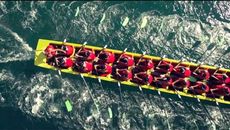
Be Extraordinary - Digicel Samoa
Voted the BEST TV Commercial in Samoa. Digicel Samoa's 'Be Extraordinary'. Well done to Digicel for winning the best Marketing Campaign for 2013 at a recent International Telecommunications Event. Malo Lava Digicel! Seki A Digicel! The majestic Zita Martel in Digicel's winning commercial, check out Zita's extraordinary life.
-
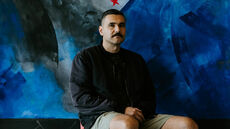
Benjamin Work - the enriching value of Tongan Visual Language
Check out the beautiful work of Tongan artist Benjamin Work, who has just been named the 2025 Matafatafa Aho Pacific Artist in Residence at the Auckland Museum. Benjamin’s art draws from Tongan cultural history, Indigenous mark-making, and visual language systems, spanning his paintings, installations, and large-scale murals. His residency sees him spend three months working within the Museum’s Documentary Heritage collections to produce a new artwork. Benjamin Work highlights the enriching value of Tongan Visual Language and it’s powerful ability to restore. * Cover photo credit: Vinesh Kumaran Born and raised in East Auckland, Benjamin Work is an Auckland-based artist with a practice largely motivated by the semiotic language of Tongan kupesi. Influenced by both his Tongan (Vava’u) and Scottish heritage, he speaks to Taualofa Totu’a on the privilege of learning from a lineage of storytellers, building a community of mentorship in Tongan knowledge and his faith in the future of Tongan art. {{26025}} For Benjamin Work, the personal Tongan education received in his upbringing, was a visual experience empowered by the senses. Observing his mother’s interactions with koloa whilst embracing the sights and scents of Tongan culture, are core memories that remain for the artist today. These experiences formed an ongoing curiosity for Tongan history and a sacred traditional practice respected as the women’s domain. Pictures and symbols found on the Ngatu around his home intrigued a young Work, who sought answers to questions about a land far from suburbia and life in Aotearoa. {{26016}} “I started questioning and asking and I was just intrigued. I gleaned as much as I could from my mother and then I looked at publications, talked with relatives... It wasn't until much later that I was introduced to Kolokesa Māhina-Tuai, who then introduced me to her father, Hūfanga Dr Ōkusitino Māhina.” Through the vision of hindsight, Benjamin now truly understands the value of this education that can not be found in a typical classroom. Also an early member of Aotearoa’s most notable graffiti collective TMD, he speaks on the beauty of kupesi, a unique imagery with links to ancient knowledge, geography, and Tongan genealogical history. {{26018}} Work was able to draw parallels to the colour association and use of Tongan fonts in Ngatu to his personal Tongan experience with the Tongan gang communities here. Amidst the insecurity of diaspora experiences, Benjamin’s desire to gain greater access to Tongan knowledge - mainly from traditional pre-Christianity, suppressed by strict laws - grew; nurtured by what he describes as key knowledge holders who are good at sharing. “I think that’s what we need, the diaspora needs elders who can share - otherwise we don't have access! We weren’t born in the islands. If that knowledge is held in, there is no opportunity for it to benefit our community overall”. {{26021}} In 2011, the artist was introduced to the semiotic language on Tongan weaponry or ‘akau tau. Drawn to the knowledge of men’s labour and masculinity in form, Benjamin yearned to understand the coded meanings and history behind the weaponry that had been removed out of Tonga’s sight. “On Cook’s voyages in the Pacific, the Tongan war club was his most collected item, compared to all the items he collected in Aotearoa, Tahiti and Hawaii. The highest number of artifacts were the Tongan war clubs. Just imagine how many are distributed all over the world - yet we don’t have many back in our homeland.” {{26023}} The men’s weaponry was a welcome change of view from the material culture he had always known, a space he wanted to honour for Tongan women. “I really feel that they should thrive because women have been the carriers of this for generations and generations. Who am I to change that for this individual pursuit?” {{26014}} Looking forward, Benjamin is confident that the future of Tongan art is strong. Establishing and validating connections with fellow Tongan artists is a priority for him, as well as encouraging more Tongans to publish our own stories. “It’s important to validate and encourage younger artists who may feel insecure about what they are trying to say. Every experience is valid. You’re not more Tongan if you can do this or do that. That’s something I learnt as an adult.” {{26027}} Changing the past is impossible but through his artist ventures and open discussion spaces like The Kava Book Club opened alongside Tongan Tātatau artist Terje Koloamatangi, there is more of Tonga being restored and reintroduced to its people abroad. “That’s the uniqueness of the artists of Moana and Tangata Whenua as well. When we work, it’s not a Western individual practice. From within, we understand that there is this responsibility to our people as a whole and know the māfana and faka'apa'apa that comes with it. At the end of the day, we want our people to be proud - first and foremost.” - From the 20th to the 23rd of August 2023, 'Bodies of Water, Made of Land' will be one of the six exhibitions included in Te Tuhi Art Gallery’s exhibition and is a collaborative work by Work and Harrison Freeth that references the interconnections between body and land through the concepts of Vā (relational space) and Tā (time). - Throwback to the time Ben was in Tonga and learned Ta'ovala 101 from local Tongan expert Favine Fakahau Lumsden who explains when and why Ta'ovala are worn in the Kingdom. {{26028}}
-
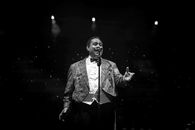
BEN MAKISI - ARTIST PROFILE
Ben Makisi aka The Polynesian Pavarotti - our very own international Opera Singer singing his way around Europe! Benjamin Fifita Makisi was born in Wellington, NZ and is of Tongan and Samoan descent. He began singing at a young age with the Tongan Wesley Methodist church choir in Wellington. He graduated with a Master of Performance (Opera) with High Distinction from the University of Sydney Conservatorium of Music and a Bachelor of Music (Performance) from Victoria University Wellington. He had also received his tutoring in New York, London and in Italy.
-

BENSON WILSON - Samoan Baritone 'Most Promising Opera Singer'
Congratulations Benson! So awesome to see Polys doing well in Opera! Check him out in the promo vid above for Operanesia (a collaboration between four classically trained singers who all hail from Auckland via the Pacific Islands of Samoa and Tonga) The Baritone singer won the acclaimed Lexus Song Quests Grand Gala Final last night and was crowned 'Most Promising Opera Singer'. He was up against 3 other finalists - 2 of whom were also of Pasifika descent. His prize package included an immediate cash prize of $20,000, a Study Scholarship of $27,000, plus economy international travel up to the value of $3,000. {{20387}} He has been a member of the New Zealand Youth choir since 2011 and also works as a vocal coach at several high schools in Auckland. He's hoping to pursue post graduate training at one of the elite music institutions in the UK next year. We're looking forward to hearing more from #BaritoneBenson in the future - Bravo Benson! Suggested Links: Bravo to our Lexus Song Quest Finalists Sole Mio's Amitai Pati discusses new album
-
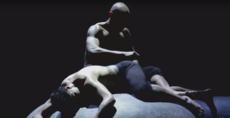
Black Grace: Siva - Neil Ieremia
“Siva explodes from the collision of the past and future, capturing our common beauty, our shared history and divine difference. It is more than a celebration of the past - with our fears arrested, it is about rushing headlong into the future.” – Neil Ieremia
-
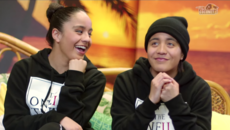
Born To Dance Interview with Jordan & The O'Neill Twins
Born To Dance (2015) Jordan Vaha'akolo-Cruickshank & The O'neill Twins share some funny moments while working on set for NZ's first ever dance film, choreographed by Parris Goebel & directed by Tammy Davis "Coming of age tale told through the eyes of 'Tu', an ambitious young man from Auckland who dreams of being a professional hip-hop dancer." Born To Dance premieres September 24th in New Zealand & November 5th in Australia.
-
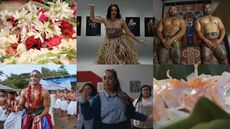
CELEBRATING 10 YEARS OF THE COCONETTV
Celebrating 10 years of the Coconet TV!! We are so happy to have been able to bring you the stories that have won the hearts of our Moana people around the world, which we have had the privilege and joy of making over the last decade. From the smash hit films 'Inky Pinky Ponky' to 'Teine Sa' and a raft of award winning documentaries, and hundreds of stories from our communities - the Coconet has become the home for our Pasifika aiga near and far. #ForThePeople #ByThePeople is the mantra of our collective of Coco creatives and the all Pasifika teams and crews that we have developed over the years. ' We are so proud to have brought through hundreds of Pasifika production people, crew and talent in this time, and to have worked with our communities across the Moana Nui A Kiwa. Ia Maniua - #KeepItCoco and experience our collective joy and alofa as Pasifika people in this special trailer: https://www.thecoconet.tv for more from the Coconet aiga xx
-
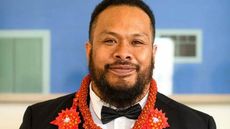
Creative Native: Kalisolaite 'Uhila
Ever wondered what it may be like to live like a pig? Tongan artist and #CreativeNative Kalisolaite 'Uhila did just that all in the name of art - check out his exploration into the use of the pig in our Pacific culture, and how he and the pig became one! Think you know you're Ta'ovala? Check out the do's and don'ts here
-

Creative Native: Kalisolaite 'Uhila
Ever wondered what it may be like to live like a pig? Tongan artist and #CreativeNative Kalisolaite 'Uhila did just that all in the name of art - check out his exploration into the use of the pig in our Pacific culture, and how he and the pig became one! Think you know you're Ta'ovala? Check out the do's and don'ts here
-
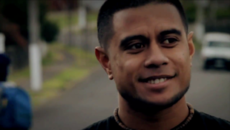
Creative Native: Monty Collins
Creative Native Monty Collins takes us into his world of graffiti, cartoons, and the love for his art. If you drive around most of Auckland and notice the amazing female character graffiti work on some of the walls, chances are they are done by this talented artist! Check out Mangere-based graffiti artist Monty Collins as he tries to put a positive spin on graffiti out in South Auckland, and change the perceptions on how people view the art form. Check out some more of Monty's work here
-
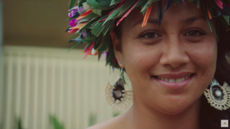
Creative Native - Nanave Taime
Young Cook Islands weaver and jewellery designer Nanave Taime grew up in Tongareva aka Penryhn and was inspired by her grandmother to take up the art of weaving. She now creates beautiful jewellery out of rito and mother of pearl. She's determined to pass this knowledge on to both of her young daughters who have already shown an interest in following in their mothers artistic footsteps.
-
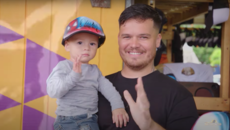
Creative Native - Ollie Peyroux
Ollie Peyroux and his family run a fun creative surf gear shop! In this segment, we get to check out his colorful shop and the passion behind his art. - Creative Natives profile artsy and out of the box Pacific thinkers who are reimagining their surroundings to bring something different to life. Find Ollie's full Fresh Episode HERE
-
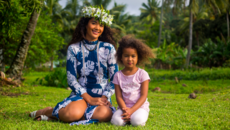
Creative Native - Poevai Garnier
Meet the creative mind behind beautiful Pacific jewelry. Poevai Garnier is a talented creative native. We travel to meet her in the islands as she shows us some of her precious gems and tells us the story of how she went from creating her own adornments to starting a business with her skills. - Creative Natives profile artsy and out of the box Pacific thinkers who are reimagining their surroundings to bring something different to life.
-
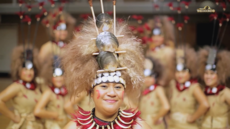
Cultural Refresh - Tuiga
Commonly worn by a taupou or manaia - the lead dancer of a Samoan performance, the tuiga is also seen on many other important occasions to signify the status of the family and village of the wearer. Once made with the real hair of family members tightly woven into the scalp, the tuiga and its various components hold many meanings and metaphors. Find out more about the ways this age old headdress has been worn and how these occasions have evolved over time, as this beautiful measina Samoa has moved into the modern world. - ‘Cultural Refresh’ is a series that explores Moana cultural practices and taonga, presented for our new generations of young Pasifika people. -
-
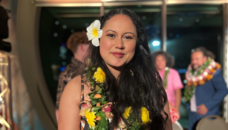
DAHLIA MALAEULU - CREATIVE NZ PASIFIKA ARTS 'EMERGING PACIFIC ARTIST' AWARD WINNER
Dahlia Malae'ulu was one of 8 Pasifika artists to win an award at the 2022 Creative New Zealand Pasifika Arts awards - an Emerging Pacific Artist award for her contribution to Pacific arts in New Zealand. She was also the only female in this years recipients. The Samoan New Zealander is an award-winning author, publisher and creator of Mila’s Books – Pasifika children’s books that help tamaiti to be seen, heard and valued as Pasifika. {{30475}} She is the first Pasifika author to have stories published across all schooling levels and travels around Aotearoa in a variety of reading advocacy roles. - We caught up with Dahlia for a quick Q&A prior to the awards ... Describe your art to us, what’s unique about it to you? I am a Pasifika children's author, publisher and creator of Mila's Books - Pasifika children's books that help our tamaiti to be seen, heard and valued. We are the only all Pasifika publishing team of children's books in the world who have produced Pasifika stories across all schooling levels. Through our Mila's Books stories we have proven what is possible for us as Pasifika writers and independent publishers of our own stories. We have also shown that there is a real hunger and need for stories by us, for all of us. {{30477}} What do you love about doing what you do? I love sharing the power of our stories as Pasifika and being able to hold up a mirror to our tamaiti to show them we are more than enough as Pasifika. Our stories help us to connect, talanoa and heal. This is why our work at Mila's Books will always be more than books for us. - Tell us your next or upcoming project? We are currently juggling a number of book projects which will be released in 2023. One book project is called, Pasifika Navigators, which will be the first Pasifika student poetry collection in the world. We worked with students with a variety of writing abilities across Aotearoa for this particular project and it was a reward in itself to support our tamaiti to discover and develop their storytelling skills, while showing the world that our stories as Pasifika are worthy of being published and celebrated. {{30479}} What inspires you in life and in your art making? From the beginning Mila's Books has always been about our tamaiti, and ensuring that our next generation understand that as Pasifika, we are enough and are more than capable of succeeding as ourselves. My own two sons inspired my author journey and the impact our stories are making on our tamaiti, schools and families continues to inspire me and reinforces the real need for our stories. For instance, we continuously receive feedback about our junior stories helping families and educators learn our languages in a fun, safe and accessible way. {{30481}} I have also had teenagers shed tears in front of me as they shared how our young adult titles have helped them to navigate and articulate how they do not feel accepted as Pasifika here in Aotearoa. There has even been feedback from parents who have told us that our stories have strengthened their relationships with their children and their connection to our culture. School leaders and organisations using our stories tell us about how our stories provide cultural understanding which helps to inform their professional practices to better support our tamaiti. This is the power of our stories and why our tamaiti will always be at the heart of everything we do at Mila's Books. {{30483}}
-
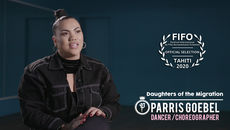
DAUGHTERS OF THE MIGRATION - PARRIS GOEBEL
The Coconet TV is proud to kick off its 'Daughter's of the Migration' series celebrating the impact Pacific women have had in Aotearoa over the generations. The Samoan supernova that is Parris Goebel tells the little-known story of her family dynamics growing up in South Auckland, and the strong sisterhood that helped her build a global legacy. We celebrate this trailblazing Kiwi-Islander in this special glimpse into her life, with these rare captured moments of one of the busiest women in the biz.
-
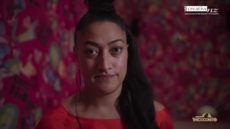
Declaration: A Pacific Feminist Agenda
Pasifika artists breathe new Moana energy into the Auckland Art Gallery, with a new group art exhibition. 'Declaration: A Pacific Feminst Agenda' brings together 12 artists from across the Pacific whose works explore some of the most pressing issues of our times: climate change and resilience, tino rangatiratanga (sovereignty), activism and social justice. - 'Declaration: A Pacific Feminist Agenda' features works by Jasmine Togo-Brisby, Marti Friedlander, Jessicoco Hansell, Taloi Havini, Lonnie Hutchinson, Ioane Ioane, Sione Monū, Suzanne Tamaki, Latai Taumoepeau, Molly Rangiwai-McHale & Luisa Tora and Kalisolaite ’Uhila. - Date: Sat 26 Mar 2022 — Sun 31 Jul 2022 Curated by Ane Tonga Location: Auckland Art Gallery Toi o Tāmaki Cost: FREE
-
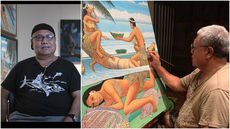
ELENI – NAVIGATORS OF POLYNESIA | FARAIMO PAULO
Faraimo Paulo is a traditional painter, carver and designer from the islands of Tokelau. Traditional painter, carver and designer Faraimo Paulo of Tokelau is on a mission to record his people’s history and culture. As emigration and rising water levels from global warming threaten to erase the traditional Tokelauan lifestyle, Paulo has embarked on a mission to realistically capture on canvas the culture, stories and scenes of Tokelauan society, often using his family members as models. {{20728}} Faraimo has a unique style of art he calls “patterns and weaving” drawing inspiration from patterns Polynesians use on tattoos and clothing, as well as weaving used in every life. He has spent the last 20 years building his collection and has just finished his first exhibition in Logan, Brisbane.
-
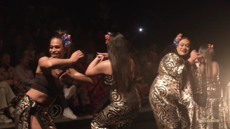
F.I.N.E Festival 2022 - Opening fiafia night highlights
Enjoy highlights from the F.I.N.E Festivals opening fiafia night at the Mangere Arts Centre showcasing Pasifika LGBTQI+, MVPFAFF+ performing artists. The festival itself ran over 3 days and was run by F’INE Pasifika Aotearoa Trust celebrating Pasifika rainbow and queer communities. F.I.N.E festival featured a series of workshops, facilitating a space to exchange knowledge with the wider community, while also giving artists an opportunity to creatively tell their stories.
-
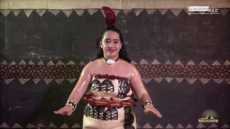
Fakalala Artist Lesieli Tonga Kafa | Creative Native
In a new Pasifika arts series we explore the different art forms of creatives across the Moana who bring joy to the world through their talents. Check out the art of Fakalala making in Tonga, and the making of this beautiful tau'olunga costume by Tongan artist Lesieli Tonga Kafa. Lesieli tells us the history behind this important cultural element and the story of its significance for Tongans worldwide.
-
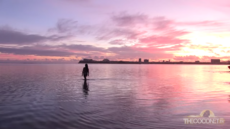
Fale Sa by Nathaniel Lees at FestPac in Guam!
Veteran Samoan actor/writer/director Nathaniel Lees brings his beautiful performance art piece to life at this year's Festival of Pacific Arts in Guam! Performed on a gorgeous beach at dawn, FALE SA invokes the legend of Tagaloa a Lagi and the spirit of Creation!
-
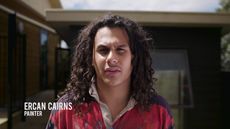
Fresh out Da Box - Ercan Cairns
Tongan/Maori artist Ercan only picked up a painting brush last year after being inspired by a Basquiat documentary. He's recently returned from an artists residency in Tonga with Tevita Latu at the Seleka Arts Studio. Find out why he's Fresh out Da Box
